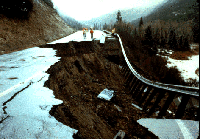

The Program
The National Landslide Hazards Program (NLHP) has operated since the mid-1970's in gathering information, conducting research, responding to emergencies and disasters, and producing scientific reports and other products for a broadly based user community. The NLHP provides results of investigations for use by private consultants in geology and geotechnical engineering, and planners and decision makers from governmental entities at all levels. The results of these efforts have led to significant improvements in understanding the nature and scope of ground-failure problems nationally and worldwide. Such improvements are central to the role of the program, because opportunities remain for fundamental advances in understanding that promise to save lives and dollars nationwide.
Slope failure near McClure Pass, Colorado |
The Landslide Problem
Landslides constitute a major geologic hazard because they are widespread, occurring in all 50 states, and cause $1-2 billion in damages and more than 25 fatalities on average each year. Landslides pose serious threats to highways and structures that support fisheries, tourism, timber harvesting, mining, and energy production as well as general transportation. Landslides commonly occur with other major natural disasters such as earthquakes and floods that exacerbate relief and reconstruction efforts and expanded development and other land use has increased the incidence of landslide disasters.
Landslides are common throughout the Appalachian region and New England. The greatest eastern hazard is from sliding of clay-rich soils; related damages in urban areas such as Pittsburgh,PA, and Cincinnati, OH, are among the greatest in the U.S. Landslides also occur across the Great Plains and into the mountain areas of the western U.S. in weathered shales and other clay-rich rocks particularly where there are steep slopes, periodic heavy rains, and vegetation loss has occurred after wildfires. Earthquakes and volcanoes also cause landslides; the catastrophic 1980 eruption of Mount St. Helens in Washington was preceded by the by the development of a large landslide on the north side of the volcano. The Northridge earthquake in 1994 in the San Fernando Valley triggered thousands of landslides in the Santa Susanna Mountains north of the epicenter.
The enormous damages from landslides can be reduced. The primary objective of the Landslide Hazards Program is to reduce long-term losses from these hazards by improving our understanding of the causes of ground failure and suggesting mitigation strategies.
| Top of page | Landslides | Geologic Hazards Team |
| U.S.
Geological Survey, U.S.
Department of the Interior Comments and feedback: Webmaster URL is: Page last modified/created: 4 December, 2003 FOIA || Privacy Statement || Disclaimer || Accessibility |